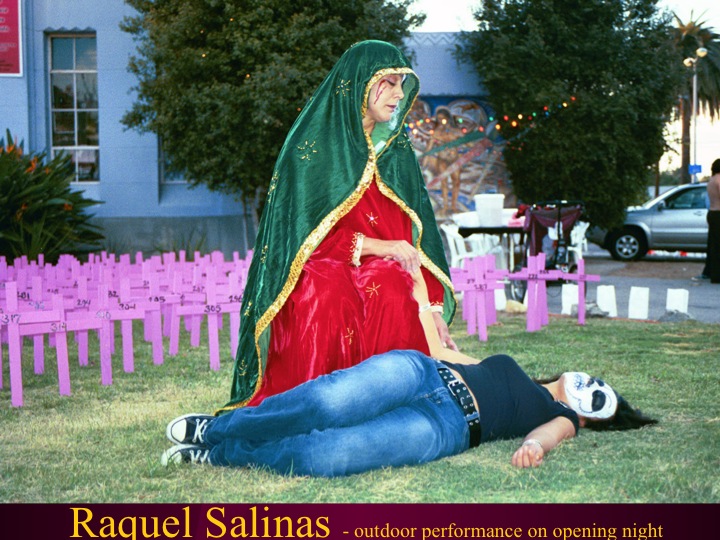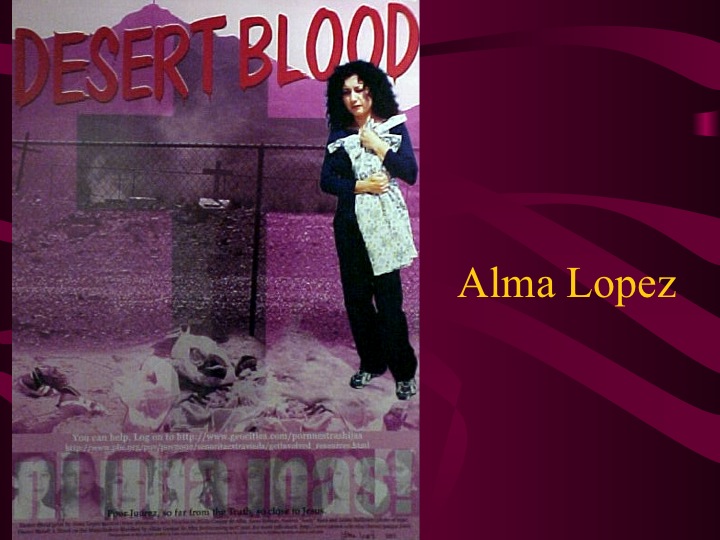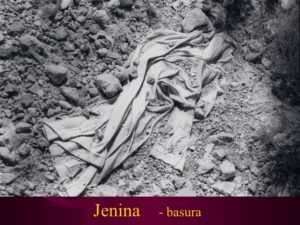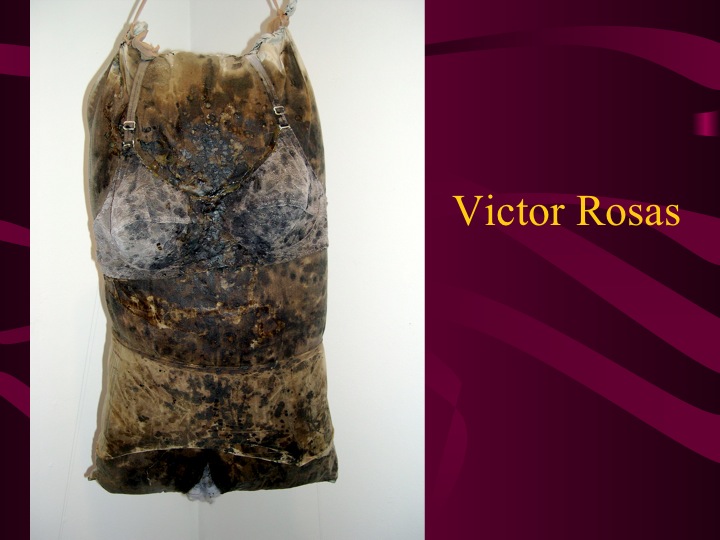
“In 2002, the mother of Laura Berenice Ramos Monárrez a desaparecida from the maquilas in Ciudad Juarez, gave me her photo to create this painting. I never documented it before I shipped it to the National Museum of Mexican Art (Chicago) for their permanent collection. Her Mother said to me, ‘A Laura Berenice le gustaba sus frijoles y sopita aguada. Le encantaba bailar.‘ Laura Berenice was 17 years old. Que en paz descanse.” – Victoria Delgadillo
Background
On November 4, 2007, the Inter-American Commission on Human Rights filed a case against Mexico for the disappearance and murders of Claudia Ivette González, Esmeralda Herrera Monreal and Laura Berenice Ramos Monárrez. The murders occurred in Ciudad Juárez, a city on the border of the U.S. and Mexico, where gender-based violence, including abduction, rape and murder of young women became endemic in the 1990s. The bodies of the women, two of whom were minors, were discovered on November 6-7, 2001 in an abandoned cotton field known as Campo Algodonero. The case was submitted to the Inter-American Court of Human Rights, which held two public hearings on April 28, and 29, 2009.
Outcome
On December 10, 2009, the Inter-American Court of Human Rights found Mexico in violation of human rights obligations under the American Convention of Human Rights and the Convention of Belém do Pará. The Court ordered Mexico to comply with a broad set of remedial measures including constructing a national memorial, renewing investigations, and providing reparations of over $200,000 to each of the families involved in the lawsuit.
Read More on this case —Warning: This case deals with topics that are especially grave and may cause trauma invoked by memories of past abuse. If you have experienced violence and need assistance, please refer to this list of country help lines provided by UN Women.



































 Gloria Evangelina Anzaldua (1942-2004) is a major figure in many inter-disciplines, disciplinary areas of scholarship and art. She was born in the U.S., in the Rio Grande Valley at the border of Texas and Mexico into a family that had been in the U.S. for six generations, and died in Santa Cruz, California. Anzaldua contributed foundational works to Chicana/o/x cultural theory, feminist theory and queer theory. She is one of the first if not actually the first to construct queer theory within the academy in the 1980s. She co-edited the ground-breaking book on women and queers of color feminism, This Bridge Called My Back. Anzaldua is a major writer of literary essays, poetry, short stories and children’s books. Her illustrations have been the subject of art exhibits. Her most renowned sole-authored book, Borderlands/La Frontera: The New Mestiza, has been translated into multiple languages and is currently being translated into French. It is a multi-genres book including auto-biography, auto-historia, auto-historia-teoria, political essays, literary musings, and poetry. In it, Anzaldua performs the process of decolonizing language by shifting from English (the main language of the book) into Tex-Mex Spanish and into Nahuatl, an indigenous language, to create what she called an infant language, this bastard language, Chicano Spanglish which is not approved by any society.
Gloria Evangelina Anzaldua (1942-2004) is a major figure in many inter-disciplines, disciplinary areas of scholarship and art. She was born in the U.S., in the Rio Grande Valley at the border of Texas and Mexico into a family that had been in the U.S. for six generations, and died in Santa Cruz, California. Anzaldua contributed foundational works to Chicana/o/x cultural theory, feminist theory and queer theory. She is one of the first if not actually the first to construct queer theory within the academy in the 1980s. She co-edited the ground-breaking book on women and queers of color feminism, This Bridge Called My Back. Anzaldua is a major writer of literary essays, poetry, short stories and children’s books. Her illustrations have been the subject of art exhibits. Her most renowned sole-authored book, Borderlands/La Frontera: The New Mestiza, has been translated into multiple languages and is currently being translated into French. It is a multi-genres book including auto-biography, auto-historia, auto-historia-teoria, political essays, literary musings, and poetry. In it, Anzaldua performs the process of decolonizing language by shifting from English (the main language of the book) into Tex-Mex Spanish and into Nahuatl, an indigenous language, to create what she called an infant language, this bastard language, Chicano Spanglish which is not approved by any society.




























 CHICANO DREAM at the Museum d’Aquitaine, Bordeaux, France
CHICANO DREAM at the Museum d’Aquitaine, Bordeaux, France









